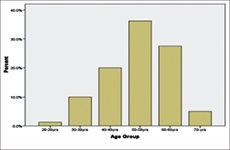Topical Anaesthesia for Pain Relief During High Dose Rate Brachytherapy for Carcinoma of the Cervix
Main Article Content
Abstract
Purpose: To determine the clinical efficacy of a local anaesthetic spray of 10% xylocaine in reducing pain and discomfort in patients undergoing high dose rate (HDR) brachytherapy.
Patients and Method: Ninety two consenting patients diagnosed with cervical cancer and planned for HDR as part of their treatment were enrolled for the study. Each patient had three sessions of brachytherapy following the standard procedures. In the first session all the patients had brachytherapy in the usual manner with conscious Sedation with parenteral diazepam and pentazocine. For the second and third sessions, they had treatment sessions using conscious sedation and 10% xylocaine spray and a control session using conscious sedation and a placebo spray with 0.9% normal saline (NS) respectively. Visual Analogue Scale (VAS) was used in assessing pain during each of the procedure.
Results: Only 80 patients completed the study. Their age ranged from 28-70 years with a median age of 54 years. The pre-treatment VAS median scores in the treatment and the control sessions were similar at 0.275 and 0.200. However, the post-procedure median VAS scores were increased to 6.3 in the control group and 3.2 in the xylocaine-treated group (P < 0.0001). The haemodynamic status including the blood pressure (BP) and pulse rates (PR) were similar pre and post procedure in both groups.
Conclusion: Topical xylocaine spray is efficacious in reducing pain and discomfort in HDR Brachytherapy without any appreciable adverse effect.
Downloads
Article Details
Section

This work is licensed under a Creative Commons Attribution-NonCommercial 4.0 International License.
This is an open access journal, and articles are distributed under the terms of the Creative Commons Attribution-NonCommercial-ShareAlike 4.0 License, which allows others to remix, tweak, and build upon the work non-commercially, as long as appropriate credit is given and the new creations are licensed under the identical terms.
How to Cite
References
1. Saibishkumar EP, Patel FD, Sharma SC. Evaluation of late toxicities of patients with carcinoma of the cervix treated with radical
radiotherapy: An audit from India. Clin Oncol (R Coll Radiol) 2006;18:30‑7.
2. Smith MD, Todd JG, Symonds RP. Analgesia for pelvic brachytherapy. Br J Anaesth 2002;88:270‑6.
3. International Association for the Study of Pain: Pain Definitions [cited 10 Sep 2011]. Derived from Bonica JJ. The need of taxonomy. Pain 1979;6:247‑8.
4. Prkachin KM, Solomon PE, Ross J. Underestimation of pain by health‑care providers: Towards a model of the process of inferring
pain in others. Can J Nurs Res 2007;39:88‑106.
5. McCaffery M. Nursing Practice theories related to cognition bodily pain and man environment interactions. University of California
at Los Angeles: Student’s Store; 1968. p. 956.
6. Ahmad G, Attarbashi S, O’Flynn H, Watson AJ. Pain relief in office gynecology: A systematic review and meta‑analysis. Eur J Obstet
Gynecol Reprod Biol 2011;155:3‑13.
7. Kwekkeboom KL, Dendaas NR, Straub M, Bradley KA. Patterns of pain and distress during high‑dose‑rate intracavity brachytherapy
for cervical cancer. J Support Oncol 2009;7:108‑14.
8. Abdus‑Salam A, Ogunnorin O, Abdus‑Salam R. HIV Seroprevalence in Patients with Carcinoma of the Cervix in Ibadan, Nigeria. Ghana Med J 2008;42:141‑3.
9. Uzoigwe SA, Seleye‑Fubara D. Cancers of the uterine cervix in Port Harcourt, Rivers State‑‑a 13‑year clinico‑pathological review.
Niger J Med 2004;13:110‑3.
10. Badar F, Anwar N, Meerza F, Sultan F. Cervical cancer in a Muslim community. Asian Pac J Cancer Prev 2007;8:24‑6.
11. Ijaya MA, Aboyeji AP, Olatinwo AW, Buhari MO. Clinico‑pathological presentation of primary cervical cancer seen in Ilorin, Nigeria. Niger J Surg Res 2002;4:89‑92.
12. Chen HC, Leung SW, Wang CJ, Sun LM, Fang FM, Huang EY, et al. Local vaginal anesthesia during high‑dose‑rate intracavitary
brachytherapy for cervical cancer. Int J Radiat Oncol Biol Phys 1998;42:541‑4.
13. Midhail MG, Bevan JR. A randomized trial of the use of cocaine spray to provide relief during laser vaporization of the cervix. Br
J Obstet Gynaecol 1988;95:469‑72.
14. Chan CP, Lau FL. Should lidocaine spray be used to ease nasogastric tube insertion? A double‑blind, randomized controlled
trial. Hong Kong Med J 2010;16:282‑6.


